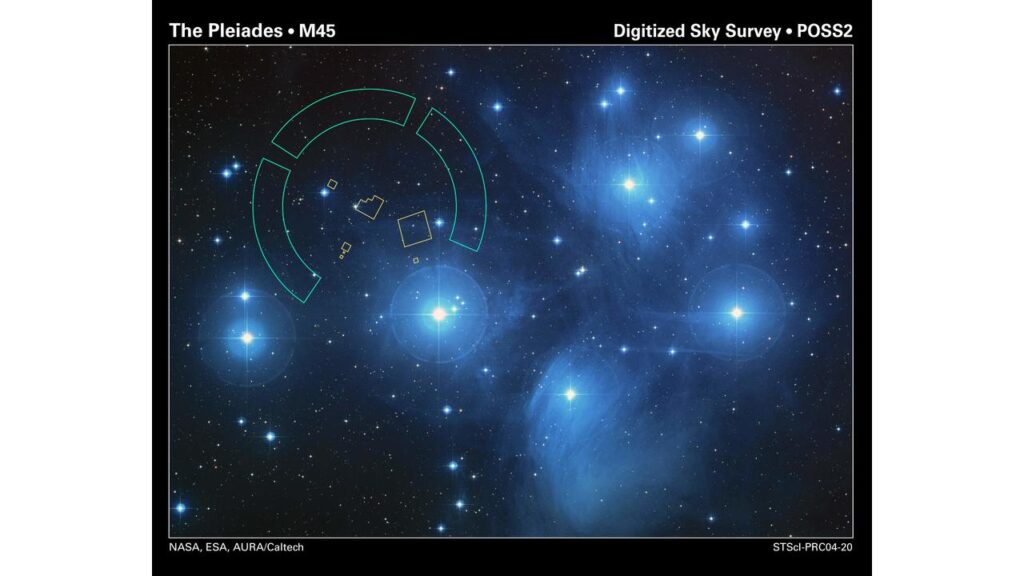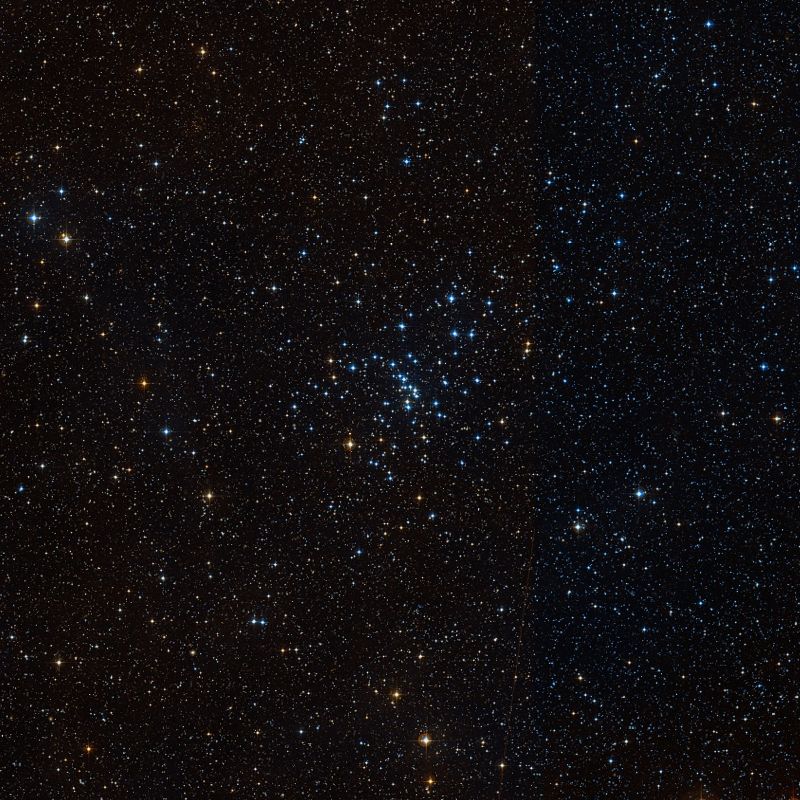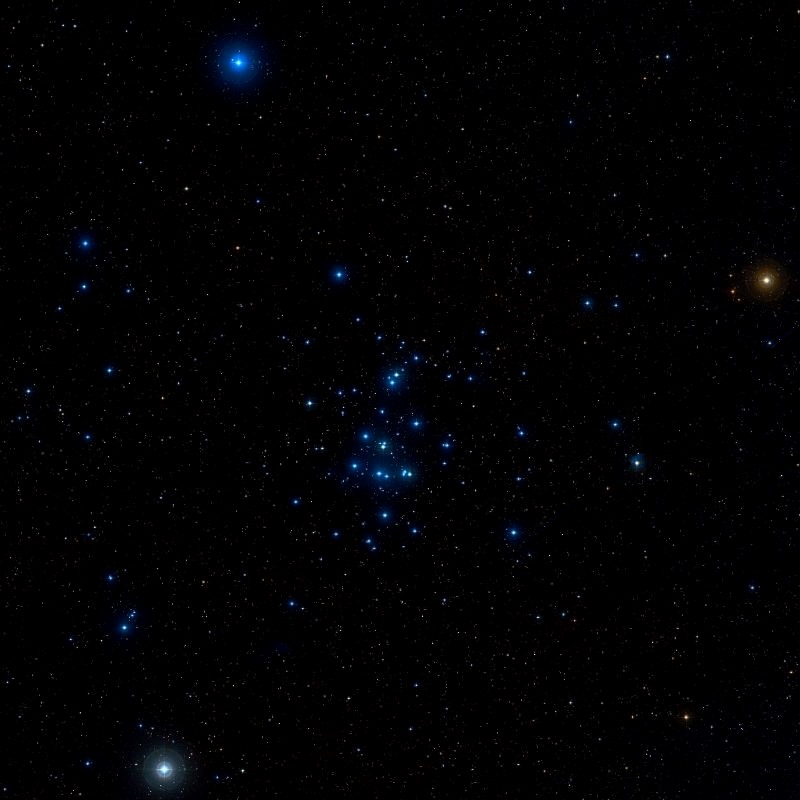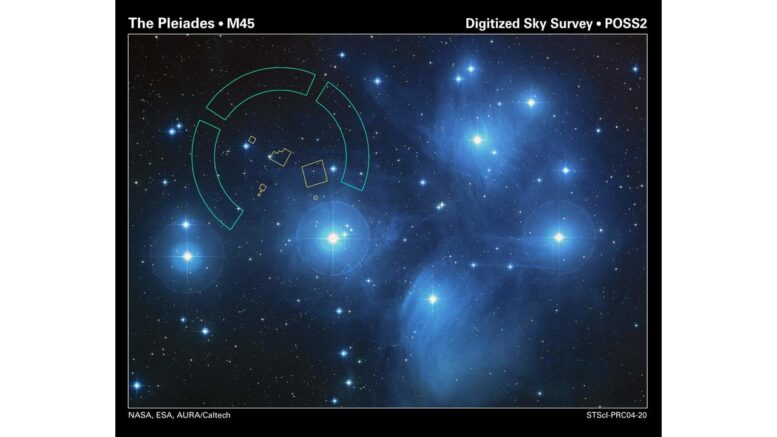When looking in the sky, there are several easy and well known open cluster objects that are visible from the Pacific Northwest and other Northern Hemisphere observing locations. An open cluster is a type of star cluster made of up to a few thousand stars that were formed from the same giant molecular cloud and have roughly the same age. More than 1,100 open clusters have been discovered within the Milky Way Galaxy, and many more are thought to exist.
At least one of these objects can be seen throughout most of the months of the year, but not necessarily every month of the year can they be so easily seen.
Pleiades (M45)

When Visible: September to February, with the best best times being December and January
How To Find It: The cluster is positioned about 14 degrees northwest of orange giant star Aldebaran (mag. +0.9), the brightest star in Taurus.
How It Looks: The Pleiades cluster occupies an area of 110 arc minutes, about four times the apparent diameter of the full Moon. Up to 14 stars are visible without binoculars in good conditions, with clear skies and no light pollution. The best time of year to observe M45 from northern latitudes is during the winter months, when Taurus constellation rises high in the sky. Because of the cluster’s apparent size, the best way to see it is through binoculars and small or wide field telescopes. Higher magnification is only recommended for studying individual stars.
Fun Fact: The Pleiades have been seen since ancient times.
Messier 103

When Visible: Anytime of year. Circumpolar, so object never sets
How To Find: M103 is located within Cassiopeia’s familiar W shape and can be located 1 degree east of Ruchbah, Delta Cassiopeiae, the bottom left star of the W. It lies near the line connecting Ruchbah and Segin, Epsilon Cassiopeiae, the upper left star of the W. The best time of year to observe M103 is during the winter, but northern observers can see it at any time of year.
How It Looks: It is easy to see, even with binoculars, and appears as a nebulous fan-shaped patch. 4-inch telescopes resolve the four brightest stars in the cluster. Large telescopes resolve more stars across the cluster, but make it harder to make out M103 from the surrounding star field because the cluster is quite loose.
Fun Fact: It is one of the more distant open clusters, 8,000 – 9,500 light-years from the Solar System.
Messier 48

When Visible: October to March, with the ideal time being January and February
How To Find: Look 14 degrees to the southeast of Procyon, the brightest star in Canis Minor and eighth brightest star in the sky, or 3 degrees southeast of Zeta Monocerotis, a yellow supergiant with an apparent magnitude of 4.36, located in the constellation Monoceros.
How It Looks: In binoculars and small telescopes reveal about 50 stars brighter than magnitude 13. M48 is visible to the naked eye under good atmospheric conditions.
Fun Fact: Although identified by Messier, M48 was considered lost for a long time because the coordinates provided by Messier did not match, his declination was off by 5 degrees.
M44: Beehive Cluster

How It Looks: M44 is one of the nearest open clusters to Earth and can easily be seen without binoculars. It appears as a blurry patch of light to the naked eye. The cluster is best seen in binoculars and small telescopes. Occupying an area 95 arc minutes across, it fits in the field of view of binoculars and low power telescopes. Larger telescopes reveal more than 200 stars in the cluster.
When Visible: October To March, with ideal time is February to March
How To Find: Lynx, lies to the north, while Canis Minor, with the bright star Procyon, lies to the south of M44. An easy way to find the cluster is to draw a line from Pollux in Gemini to Regulus in Leo. M44 lies about halfway along the line.
Fun Fact: The Beehive Cluster was seen by the ancients, with one of the earliest written accounts of the Cluster was in 260 B.C.
Messier 21

When Visible: June, July and August
How To Find: It is located 2.5 degrees northwest of Messier 8, the Lagoon Nebula, and only 0.75 degrees to the northeast of Messier 20, the Trifid Nebula. The cluster can be found using the Teapot asterism, formed by the brightest stars in Sagittarius, to first find either of the two famous nebulae and then use them to locate M21.
How It Looks: Although it is not visible with the naked eye, M21 contains about 35 stars with a visual magnitude between 8 and 12. Many of these stars can easily be seen in a small telescope, with 6-inch or larger telescopes will show many more stars tightly packed within an area 13 arc minutes in apparent size.
Fun Fact: The cluster contains about 57 confirmed members, but is pretty densely packed.
For other astronomical objects to observe, make sure to check out the Top 5’s and other articles on CosmosPNW to help with your journey. To stay up to date with CosmosPNW, make sure to follow us on Twitter and Instagram.

Be the first to comment on "Top 5 Easiest Open Clusters To View"